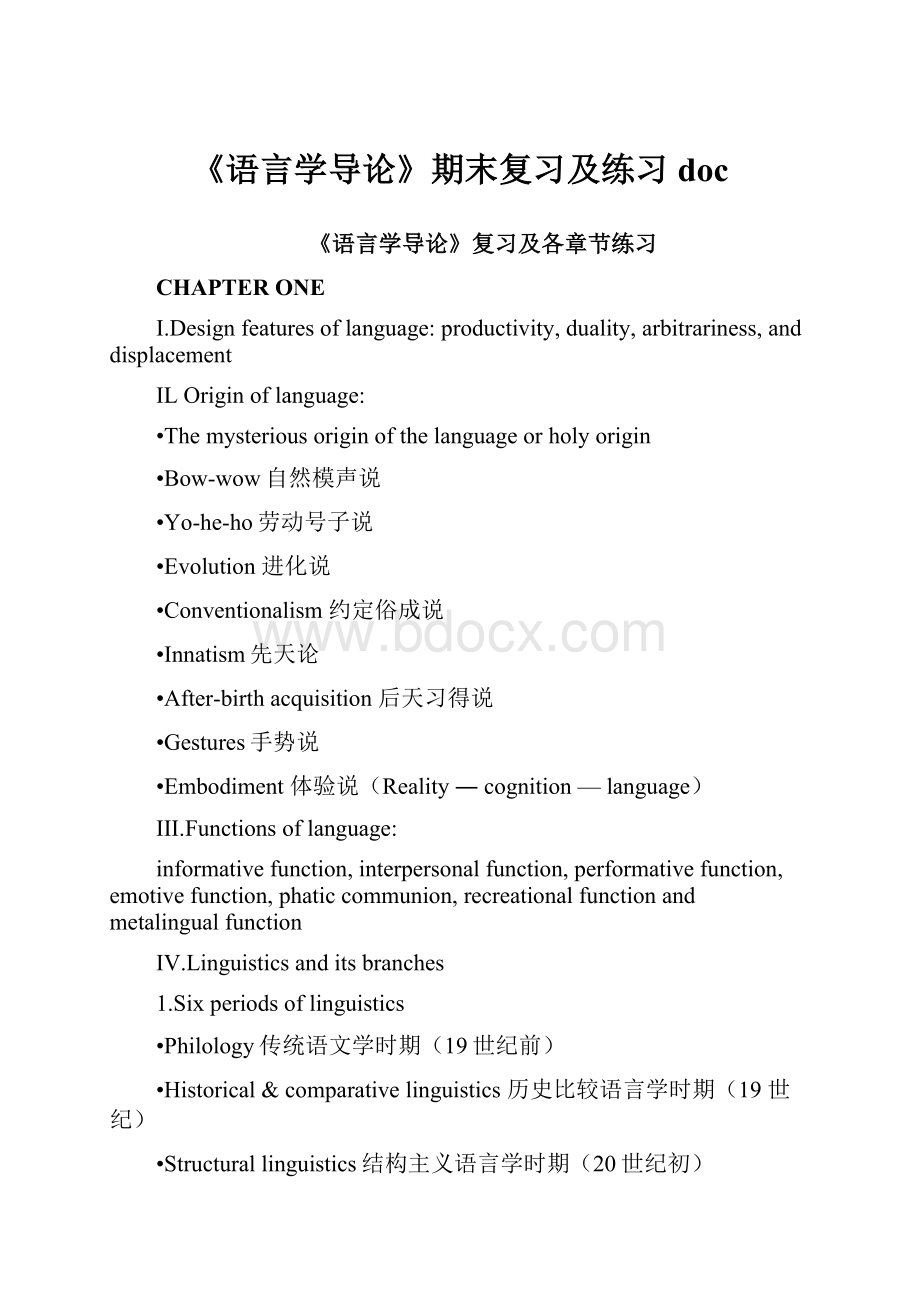《语言学导论》期末复习及练习doc.docx
《《语言学导论》期末复习及练习doc.docx》由会员分享,可在线阅读,更多相关《《语言学导论》期末复习及练习doc.docx(44页珍藏版)》请在冰豆网上搜索。

《语言学导论》期末复习及练习doc
《语言学导论》复习及各章节练习
CHAPTERONE
I.Designfeaturesoflanguage:
productivity,duality,arbitrariness,anddisplacement
ILOriginoflanguage:
•Themysteriousoriginofthelanguageorholyorigin
•Bow-wow自然模声说
•Yo-he-ho劳动号子说
•Evolution进化说
•Conventionalism约定俗成说
•Innatism先天论
•After-birthacquisition后天习得说
•Gestures手势说
•Embodiment体验说(Reality―cognition—language)
III.Functionsoflanguage:
informativefunction,interpersonalfunction,performativefunction,emotivefunction,phaticcommunion,recreationalfunctionandmetalingualfunction
IV.Linguisticsanditsbranches
1.Sixperiodsoflinguistics
•Philology传统语文学时期(19世纪前)
•Historical&comparativelinguistics历史比较语言学时期(19世纪)
•Structurallinguistics结构主义语言学时期(20世纪初)
•Functionallinguistics系统功能主义语言学时期(20世纪中)
•Transferredgenerativelinguistics转换生成语言学时期(20世纪中)
•Cognitivelinguistics认知语言学时期(20世纪80年代)
2.internalbranches:
inrea-disciplinarydivisions(内部分支)
1)Phonetics(语音学)studieshowspeechsoundsarepronounced,transmittedandperceived.
2)Phonology(音系学)isthestudyoftherulesgoverningthestructure,distributionandsequencingofspeechsoundsandtheshapeofsyllables.(研究语音和音节的结构、分布和序列)
3)Morphology(形态学)isconcernedwiththeinternalorganizationofwords.Itstudiestheminimalunitsofmeaning-morphemesandword-formationprocesses.
4)Syntax(句法学)isthestudyoftherulesgoverningthewaysdifferentconstituentsare
combinedtoformsentencesinalanguage,orthestudyofinterrelationshipsbetweenelementsinsentencestructures.
5)Semantics(语义学)isthestudyofhowmeaningisencodedinalanguage,oritisthe
studyofmeaningoflinguisticunits,wordsandsentencesinparticular.
6)Pragmatics(语用学)isthestudyofmeaningincontextorinuse.
3.externalbranches:
inter-disciplinarydivisions(外部分支:
跨学科分支,即宏观语言学分支)
1)Psycholinguisticsisthestudyoftheinterrelationoflanguageandmind.
2)Sociolinguisticsstudiesthecharacteristicsoflanguagesvarieties,languagefunctionsandspeakersasthethreeinteractandchangewithinaspeechcommunity.
3)Anthropologicallinguisticsstudiestheemergenceoflanguageandthedivergenceoflanguageoverthousandsofyears.
4)Computationallinguisticsstudiestheuseofcomputerstoprocessorproducehumanlanguage.
ChapterTwoPhonetics
1.Sub-branchesofphonetics
Articulatoryphonetics:
theproductionofspeechsounds
Acousticphonetics:
thephysicalpropertiesofspeechsounds
Auditoryphoneticsorperceptualphonetics:
theperceptivemechanismofspeechsounds
2.Groupsofspeechsounds
Consonantsandvowels
3.Waystodescribeconsonants
1)positionofarticulation
2)mannerofarticulation
3)voicedorvoiceless
4.Waystodescribevowels
1)theheightoftongueraising(high,mid,low);
2)thepositionofthehighestpartofthetongue(front,central,back)
3)thelengthortensenessofthevowel(tensevs.laxorlongvs.short);
4)lip-rounding(roundedvs.unrounded)
ChapterThreePhonology
I.PhonemesandAllophones
1.Phoneme:
adistinctive,abstractsoundwithadistinctivefeature(具有区另U意义的最小语音单位)
2.Allophones:
thevariantsofaphoneme(音位变体)
3.Contrastivedistribution(对立分布):
thetypicaltobefoundinMinimalPairs(最小对比对)。
AMinimalPairreferstotwowordswhichdifferfromeachotherbyonlyonedistinctivesound(onephoneme)andwhichalsodifferinmeaning,forexample,bearandpear.
4.Complementarydistribution(互补分布):
allophonesarenotfoundinthesameposition
5.Freevariation(自由变体):
Ifsegmentsappearinthesamepositionbutthemutualsubstitutiondoesnotresultinchangeofmeaning,theyaresaidtobeinfreevariation.
II.SuprasegmentalFeatures(超音段特征)
Theprinciplesuprasegmentalfeaturesaresyllable,stress,toneandintonation.
ChapterFourMorphology
I.Morpheme
1.Morpheme:
thesmallestmeaningfulunitoflanguage(最小的有意义的语言单位)
2.FreeMorphemes(自由语素)andBoundMorphemes(黏着语素)
1)Freemorphemes:
Morphemesconstitutingwordsbythemselvesarecalledfreemorphemes.Theyarerootsofwords.
2)Boundmorphemes:
Morphemesalwaysattachedtofreemorphemestoformnewwordsarecalledboundmorphemes.Theyareaffixesofwords,whichcanbefurtherdividedintoinflectionalaffixes(屈折词缀)andderivationalaffixes(派生词缀).
3)InflectionalmorphemesinmodernEnglishindicatecaseandnumberofnouns,tense
andaspectofverbs,anddegreeofadjectivesandadverbs.
4)Derivationalmorphemesareboundmorphemesaddedtoexistingformstoconstructnewwords.
ILWordFormation
1.Derivation(派生法)
2.Compounding(复合法)
3.Lexicalchangeproper(特有的词汇变化)
Inventionorcoinage
Blending
Abbreviation
Acronym
Back-formation
Borrowing
III.Semanticchange
Broadening(词义扩大)
Narrowing(词义缩小)
Metathesis(
Meaningshift(词义转移)
ChapterFiveSyntax
I.TraditionalGrammar(传统语法)
1.Intraditionalgrammar,asentenceisconsideredasequenceofwordswhichareclassifiedintopartsofspeech.
2.Sentencesareanalysedintermsofgrammaticalfunctionsofwords:
subjects,objects,predicatesandpredicator.
3.Nouns:
number,case,gender,countability
4.Verbs:
tense,aspect,voice
5.Agreementinnumber,personandgender
II.StructuralGrammar(结构主义语法)
1.ItwasfoundedbySaussure,whodistinguishesthelinguisticcompetenceofthespeaker
andtheactualphenomenaordataoflinguisticsasLangue(语言)andparole(言语).
2.Structuralgrammararoseoutofanattempttodeviatetraditionalgrammar.Itdealswiththe
inter-relationshipsofdifferentgrammaticalunits.Intheconcernofstructuralgrammar,wordsarenotjustindependentgrammaticalunits,butareinter-relatedtooneanother.
3.Keyconcepts:
syntagmaticandparadigmatic(associative)relations(横组合关系和纵聚
合关系/联想关系),structureandsystem(结构与系统),immediateconstituentsanalysis(直接成分分析法),endocentricandexocentricconstructions(向心结构与离心结构)
III.Transformational-Generative(TG)Grammar(转换生成语法)
1.ItwasfoundedbyNoamChomsky,whobelievesthatlanguageissomewhatinnate
TheInnatenessHypothesis(天赋4段说)andthatchildrenarebornwithaLanguageAcquisitionDevice(语言习得机缶U),whichconsistsofthreeelements:
ahypothesis-maker(假设标记),linguisticuniversal(语言普遍现象)andanevaluationprocedure(评估程序)。
2.Chomskydistinguishesalanguageuser'sunderlyingknowledgeaboutthesystemofrules
andtheactualuseoflanguageinconcretesituationasCompetence(语言能力)andPerformance(语言运用).TGGrammartakestheidealspeaker'slinguisticcompetenceastheobjectofstudy.
3.TGGrammarhasexperiencedfivestagesofdevelopment:
theClassicalTheory,theStandardTheory,theExtendedStandardTheory,theRevisedExtendedStandardTheoryandtheMinimalistProgram.
IV.Systematic-FunctionalGrammar(系统功能语法)
1.ItwasfoundedbyM.A.K.Hallidayandtakesactualusesoflanguageastheobjectof
study.
2.TheGrammarhastwocomponents:
SystematicGrammarandFunctionalGrammar.
3.Keyconcepts:
themeandrheme(主位下口述位),communicativedynamism(交际动力),
thethreemeta-functionsoflanguageideationalfunction(概念功能),interpersonal
function(人际功能)andtexualfunction(文本功能).
Summary
Schools
representatives
TheoriesandConcepts
1
Saussure
Languageisasystemofsigns.
StructuralGrammar
2
Chomsky
TGGrammar
ThePragueSchool
/
Synchroniclinguisticstudy
Languageisfunctional.
FunctionalSentencePerspective(FSP)
ThemeandRheme
TheLondonSchool
Firth
Hallidy
Theobjectoflinguisticsislanguageinactualuse.
Systematic-FunctionalGrammar
AmericanStructuralism
BoasandSapir
Bloomfield
Sapir-WhorfHypothesis
Behaviorisminlinguistics
ChapterSixSemantics
I.DefinitionofMeaning
ILG.Leechandhis7typesofmeaning:
Conceptualmeaning,Connotativemeaning,Socialmeaning,Affectivemeaning,Reflectedmeaning,CollocativemeaningandThematicmeaning.
III.Theconceptualview(概念主义观点):
semantictriangle(语义三角)byOgden&
RichardsSymbolorForm,Referent,andThoughtorReference.
IV.Contextualism(语境主义):
tobasemeaningoncontext;arepresentativeofthisapproachwasJ.R.Firth.
V.Behaviorism(彳亍为主义):
themeaningofalanguageformisthesituationinwhichthespeakeruttersitandtheresponseitcallsforthinthehearer;asupporterofthisapproachwasBloomfield,whowasaprinciplerepresentativeofAmericanStructuralism.
VI.KeyConcepts
1.Lexicalsenserelations(词汇含义关系)
Synonymy(同义关系)
Polysemy(一词多义)
Homonymy(|B]音或同形异义关系)
Hyponymy(±T义关系)
Antonymy(反义关系)
2.sententialsenserelations(语句含义关系)
Tautology(同义反复句)
Contradiction(自相矛盾句)
Inconsistency(矛盾关系)
Synonymousness(同义关系)
Entailment(衍推关系)
Presupposition(预设)
Semanticallyanomalousness(语义反常句)
ChapterSevenPragmatics语用学
I.SpeechActTheory(言语行为理论)
1.Thefirstmajortheoryinthestudyoflanguageinuse;
2.FoundedbyJohnLangshawAustin;
3.Themajorideaisthatthingscanbedonewithwords;
4.Twotypesofsentences:
performativeandConstative(行事话语与叙事话语)
5.TheoryoftheIllocutionary(行事行为理论):
LocutionaryAct(言内行为),IllocutionaryAct(言外行为),PerlocutionaryAct(言后行为)
II.ConversationalImplicature(会话含义理论)
1.ProposedbyHerbertGrice;
2.TheCooperativePrinciples(合作原则):
QuantityMaxim(数量准则)
QualityMaxim(质量准则)
RelationMaxim(关系准则)
MannerMaxim(方式准则)
Chapter1IntroductionstoLinguistics
I.Choosethebestanswer.
1.Languageisasystemofarbitraryvocalsymbolsusedforhuman.
A.contactB.communicationC.relationD.community
2.Whichofthefollowingwordsisentirelyarbitrary?
A.treeB.typewriterC.crashD.bang
3.Thefunctionofthesentence"Waterboilsat100degreesCentigrade."is.
A.interrogativeB.directiveC.informativeD.Performative
4.InChinesewhensomeonebreaksabowloraplatethehostorthepeoplepresentarelikelytosay"碎碎(岁岁)平安"asameansofcontrollingtheforceswhichtheybelievesfeelmightaffecttheirlives.Whichfunctionsdoesitperform?
A.